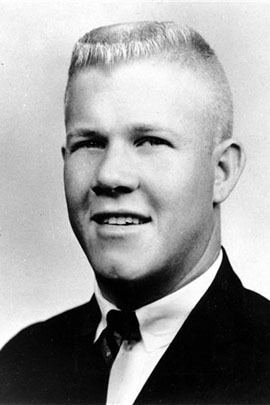
For some people, the attack on police officers by a gunman in Dallas this summer brought to mind another attack by a sniper in Austin 50 years ago — on Aug. 1, 1966. That’s when student Charles Whitman stuck his rifle over the edge of the clock tower at the University of Texas at Austin and started shooting. Ultimately, he killed 16 people — and wounded more than 30 others.
For decades, people have struggled to figure out why. There have been theories about abuse, a brain tumor and, of course, mental illness.
Six months before Charles Whitman took aim from that tower he visited a school psychiatrist, and admitted while there that he had a violent fantasy of going to the top of the tower with a deer rifle and shooting people.
Gary Lavergne, who wrote A Sniper in the Tower, said the school psychiatrist, Dr. Maurice D. Heatly, claimed he’d had many students who recounted violent fantasies during therapy sessions.
“Today we take it a whole lot more seriously because of our history,” Lavergne said. “But back then, that kind of thing didn’t happen.”
Soon after the 1966 shooting, Heatly spoke in a news conference.
“It’s a common experience for students who come to the mental hygiene clinic to refer to the tower as the site of some desperate action,” Heatly told reporters. “They say ‘I feel like jumping off of the old tower.’ [Charles Whitman had] no psychosis symptoms at all!”
Whitman never went back to the clinic, but he did return to his violent fantasy. Lavergne said the 25-year-old former Marine and Eagle Scout was incredibly methodical as he went about killing his mother the night before the tower shootings, placing her body in bed as if she were sleeping. Then he went back home and stabbed his wife.
“By 3 o’clock in the morning, his wife and his mother are both murdered,” said Lavergne. “After that, until he goes to the campus, he spent the rest of his time polishing, getting weapons ready, buying more ammunition. All for the specific goal of going to the top of the UT tower and shooting people.”
Nearly two hours later, 16 people were dead and 32 more were wounded. Police finally killed Whitman.
Speaking to the media, John Connally, who was then governor of Texas, could barely find words.
“Of course I am concerned, disturbed, and yet somewhat at a loss to know how you prevent a maniacal act of a man who obviously goes berserk,” Connally said.
Fifty years later, when news about shootings in Dallas, in Orlando or San Bernardino hits, our reactions are much the same. We avoid those charged words, but we often assume the shooter is mentally ill, and that crimes like this could be avoided if those with serious mental illness didn’t have guns.
Which raises two questions: First, was Charles Whitman mentally ill? And second, could policies focusing on mental health prevent mass shootings?
As to the first question, Lavergne said he doesn’t think Whitman had serious mental illness. Whitman, he said, did have mental health challenges that are common — depression and anxiety. But more than anything, he was manipulative.
“He was always who he was expected to be,” Lavergne said. “In front of his father-in-law, he at times appeared to be a dutiful husband, when — in fact — he assaulted his wife, just like his daddy assaulted his mother. And he gave people the impression he was an honor student, when — in fact — when he died he had a 1.9 grade point average.”
Charles Whitman did seem to think something was wrong with him. This is an excerpt from a note he left on his wife’s body:
“I don’t really understand myself these days,” he wrote. “I’m supposed to be an average, reasonable and intelligent young man. However, lately, I can’t recall when it started, I have been a victim of many unusual and irrational thoughts. These thoughts constantly recur.”

One doctor said the “grayish yellow mass” wasn’t a factor in explaining what Whitman had done. But a medical panel later diagnosed the mass as a glioblastoma and said it could have contributed to Whitman’s inability to control his emotions and his actions. Dr. Elizabeth Burton, a Dallas pathologist, agrees it’s possible.
“You can have headaches, you can have seizures, and you can have changes in cognition, and you can actually have personality changes,” she said.
But plenty of people have tumors and are not violent. And plenty of people have depression, anxiety and paranoia and aren’t violent.
Dr. Paul Appelbaum, a psychiatrist and director of the division of law, ethics, and psychiatry at Columbia University, pointed out that only a tiny percent of violence — about 4 percent in the U.S. — is attributable to mental illness.
“We know that people with serious mental disorders are at somewhat elevated risk of committing violence,” Appelbaum said. “Even so, the vast majority of them never commit a violent act. And we know that people with serious mental illnesses are much more likely to end up as victims of violence rather than as perpetrators.”
But Democrats and Republicans have both touted mental health care legislation as a way of preventing mass shootings.
After a shooter killed 20 children in Newtown, President Obama called for a gun crackdown. That didn’t happen. But, Obama’s 2017 budget does include a request for $500 million for mental health services.
Appelbaum said this is a misguided approach.
“We need more funding for treatment of people with mental illness in this country,” Appelbaum said. “But to argue for that funding on false grounds — namely to try and persuade the public that it will protect them [to] have more mental health clinics — in the long run can only backfire.”
Applebaum said he believes there are alternatives. At least temporarily limiting access to guns for some people make sense, he said. In general, people who have been convicted of violent misdemeanors, or who are a under temporary restraining order, or who have multiple DUI convictions over a 5-year period are more likely to commit acts of violence than people with mental illness are.
—
![]()
This story is part of a partnership that includes KERA, NPR and Kaiser Health News.






























Knightwatch says
It is the heigth of insanity to allow college students to carry loaded weapons into classes, dorms, cafeterias, social centers and other facilities on campus. Mental illness is difficult to identify and a sudden psychotic episode impossible to stop. Yet Teaxs is arming students and perhaps giving some the easy means to repeat the tower murders.
What madness! Oh, right, it’s Texas.
footballen says
He was a proud marine.
Why not says
It is the height of stupidity to think leaving people defenseless is what we should do! Arm the people that are going to do these things regardless of the laws and leave law abiding citizens at their mercy!! you say it yourself, a psychotic episode is IMPOSSIBLE to stop so why not give the others a fighting chance!?
Geezer says
Gun fanciers and anti-gunners ask my opinion with regard to guns.
I usually reply with: “I’m afraid of those things.”
Yet I love my vintage firearm collection.
MINE MINE MINE MINE.
BlueJammer says
I well remember the day in 1966 when Charles Whitman killed so many innocent people. At the time, I wondered to myself “Why would someone do such a terrible thing?” Fifty years later I’m still wondering the same question about “active shooters” as our media calls them.
I can only hope and pray in the year 2066 my grandchildren will no longer need to ask the same question, why?
My thoughts says
An inconsequential fact in a sad story. He grew up in Boynton Beach, FL.
proud yankee says
ISIS can only dream of killing Americans as fast as angry, white legal gun owners. The NRA and its paid for politicians is one of the biggest threats facing the american people.
its absurd how screwed up our gun laws are and they will never get fixed. When all those kids got killed at sandy hook and as a nation we did nothing thats when it became painfully clear american lives are worth far less than anyone ever would have imagined.
Sherry says
It’s the “height of stupidity” to think that continuing to arm people to the teeth will make people safer. Especially, when all factual evidence points to the contrary. Such thinking often comes into play when one is filled with fear, and paranoid that others are out there to gun me down.
Let me pose this scenario. . . so, if every citizen becomes armed with a simple hand gun. . . with none of those restrictive training, background checks, etc. How would the police stop vigilantes? If they approached say a group of kids drinking and shooting off guns on a college campus, or people firing at each other in a liquor store during a robbery how would they know who the perp was? How would they then protect themselves?
Then you take this to the next logical step. . . the (unidentifiable) bad guys would then need more powerful weapons, right? Then the police would require even MORE powerful weapons, right? Then civilians would need the same weapons as the bad guys. . . except who determines who the bad guy is?
Do you see where I’m headed with this?
Arming people more and more is nothing other than complete “self destruction”! We should absolutely face fear and hate with LOVE! Make love, NOT guns!
Geezer says
Sherry:
Chances are good that the next government will effect some changes.
Most Americans favor tightening of gun laws. Things tend to ebb and flow
in the U.S.. The pendulum is slated to swing towards the anti-gunners, and
that’s reality. Expect bans, and tighter regulations as with Bill Clinton’s
administration. The nuts have ruined it for the good guys.
But the pendulum keeps swinging, regardless of what one’s mindset will be.
I’d like to see that pendulum just stop and remain centered one day–and a
compromise for all involved.
anonymous says
It’s not just for mental health. I’ve seen a lot of crimes by people with no diagnosis commit violent acts.